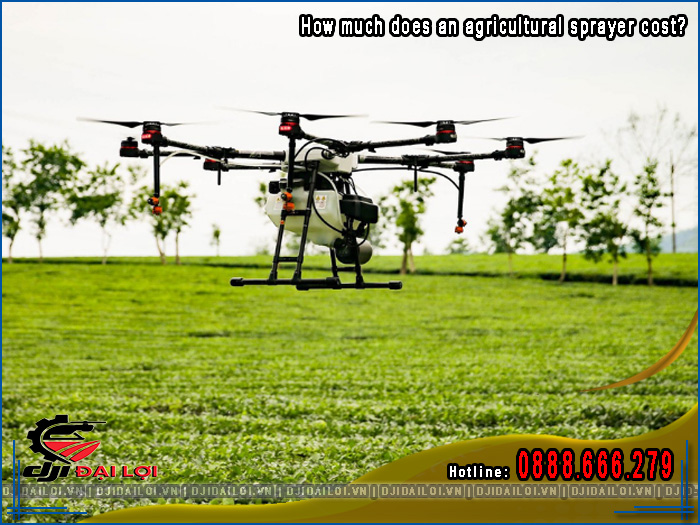
The cost of agricultural equipment is always a major concern - especially as smart farming technology advances rapidly. Among these tools, agricultural drones stand out as a modern solution to save labor, time, and money. However, prices for different drone models vary significantly: from tens to hundreds of millions of VND, depending on brand, capacity, and features. Thus, asking “how much does an agricultural spraying drone cost?” is not merely a price inquiry, but also reflects the need to balance cost, ROI, and suitability for actual farm scale.
In the Vietnamese market, agricultural drone prices typically range from 80 million to over 400 million VND. This difference is shaped by several key factors that buyers should understand before investing:
There are many agricultural drone options today, from basic budget models to AI-integrated high-end units. Understanding the differences helps you avoid overpaying or underbuying.
|
Model |
Tank Size |
Price (VND) |
Key Features |
|---|---|---|---|
|
10L |
85–110 million |
Compact, ideal for small fields, basic auto-fly |
|
|
20L |
140–170 million |
Radar, dosing spray, map management |
|
|
30L |
200–250 million |
RTK, 3D terrain scan, stable spray speed |
|
|
40L |
280–330 million |
Dual spray, omni sensors, AI flight assist |
|
|
50L |
370–420 million |
High efficiency, 25 ha/hour |
|
|
XAG V40 (China) |
20L |
120–140 million |
Cheaper, fewer sensors, harder to maintain |
Note: Prices exclude battery, fast charger, and controller - add 15–30 million VND more.
Drones may seem expensive at first glance, but analyzing usage efficiency and labor savings shows their ROI is compelling. Below is a financial model from real-world applications in the Mekong Delta and Central Highlands.
|
Item |
Details |
Estimated Cost (VND) |
|---|---|---|
|
Initial investment |
DJI T30 + accessories |
220 million |
|
Annual operating cost |
Battery + maintenance + labor |
12–15 million |
|
Annual spray capacity |
15–20 ha/day x 50 days |
~800–1000 ha/year |
|
Equivalent rental value |
250,000 VND/ha |
200–250 million |
|
Payback period |
Within 1 crop season |
~8–10 months |
Not everyone needs the most expensive or high-tech drone. Choosing the right model helps cut initial costs and ensures long-term efficiency. Here are common scenarios:
Recommended: DJI T10, XAG P20
Budget: 90–130 million VND
Reasons:
Recommended: DJI T20P, DJI T30
Budget: 160–240 million VND
Reasons:
Recommended: DJI T40, T50
Budget: 280–420 million VND
Reasons:
Options:
Recommendation: Joint purchase of DJI T20 or T30
Benefits:
With the rise of smart farming, legal awareness is also crucial. Investors in drone tech should know these points to avoid unnecessary legal or financial risks.
Many households and cooperatives face this dilemma. Both have pros and cons, but it depends on your specific situation.
|
Criteria |
Buying a Drone |
Renting a Spray Service |
|---|---|---|
|
Initial cost |
200–400 million VND |
0 VND |
|
Annual operating cost |
12–20 million VND |
Based on area used |
|
Flexibility |
Full control over schedule |
Depends on provider |
|
ROI |
8–12 months if >100 ha/year |
No asset created |
|
Risk |
Collision, failure, repairs |
Timing delays, technique gaps |
|
Long-term stability |
High if well-maintained |
Medium |
|
Upgrade flexibility |
Resale or trade-in possible |
Depends on provider |
Agricultural spraying drone prices range from 80 to over 400 million VND, depending on tank size, technology, and brand. For small-scale farms, models around 100–150 million VND are sufficient, while large-scale growers benefit more from DJI T40–T50 drones in terms of time and cost savings. If you’re not ready to fly on your own, rental or group sharing is still a smart choice. Always align your decision with actual land size, need, and budget.
No. It’s better to rent or join a shared investment to save on cost.
They include precise sensors, smart radar, and safer flight modes - making them more stable and durable, though priced 20–30% higher.
Operators must plan flight paths via software, maintain 2–3m spray height, avoid strong winds, and regularly check battery and nozzle systems.
Yes. The DJI T30 (30L) can cover 15–20 ha/day, ideal for medium-to-large coffee farms in the Central Highlands.
Yes. Many vendors now offer coverage for crashes, falls, or battery explosions - worth it for investments over 200 million VND.